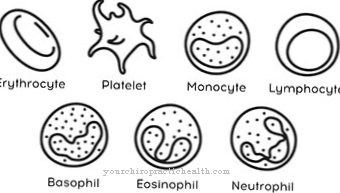A lung infection or pneumonia is mostly triggered in the colder months of the year, such as winter or autumn. Above all, bacteria, fungi and viruses play a decisive role in transmission. But other people's coughing and sneezing can also lead to droplet infections and pneumonia.
What is pneumonia?

If parts of the lungs, for example the alveoli or the tissue between them, become inflamed, it is called one lung infection or in technical terms pneumonia. The whole lungs are rarely affected; bilateral pneumonia is only possible in severe cases. Here the whole lung tissue is affected.
Since the lungs are the only organ that regulates the exchange of oxygen, these diseases should be taken very seriously and should always be treated by a doctor. Pneumonia is usually transmitted by droplet infection. This is done by sneezing, coughing, or speaking. But not all pneumonia is contagious.
Pneumonia is now the fifth most deadly infectious disease. Hundreds of thousands of people (worldwide) fall ill with this misunderstood widespread disease.
causes
The lung infection mostly caused by pathogens such as bacteria, viruses or fungi. They are inhaled through the air and inflame the alveoli or lung tissue. But an allergy can also trigger pneumonia. Previous flu or bronchitis that has not completely cured can also make the disease more likely.
Older people, whose immune system is weakened due to age, and small children, whose immune system is not yet fully developed, are also more susceptible. Another cause can be inhalation of toxic gases, for example in the event of a fire. Radiation pneumonia is when a cancer patient develops pneumonia after radiation for lung cancer.
A lungs must be well ventilated. This doesn't happen as well in bedridden patients and in many cases leads to inflammation. Another cause can be the lack of blood flow in the lungs caused by a pulmonary embolism. In some patients, the muscle at the entrance to the stomach no longer closes properly. Small amounts of stomach acid enter the windpipe and are inhaled. This can also cause pneumonia.
Rarely, this disease is caused by inhaling food particles. Water retention in the lungs, caused by certain heart diseases, can also make pneumonia more likely.
Typical symptoms & signs
Pneumonia is typically associated with difficulty breathing, fever, and chills. The body temperature rises rapidly and can easily reach more than 40 degrees Celsius. In addition, those affected feel weak and listless. The body tries to pump more air into the lungs, which is noticeable in an increased breathing rate and an increased pulse.
If these measures are insufficient to counteract a lack of oxygen, the lips turn blue. The nail bed can also be affected by this blue coloration. Furthermore, a cough occurs with pneumonia, whereby the sputum is colored brown in the later course of the disease. If the pleura is affected, there is also pain when breathing.
Older people in particular suffer from states of confusion and / or seem to vegetate to themselves. If the pneumonia is atypical, the symptoms can vary widely. In this case, the body temperature often rises only slightly and patients are more likely to suffer from a dry cough.
After the first week of illness, the fever subsides suddenly, which puts a heavy strain on the cardiovascular system. After another two weeks, the pneumonia is usually over. However, symptoms such as general weakness and mild breathing problems may still occur.
Course of disease
Basically the symptoms are with one lung infection very specific, depending on the type of infection and the general health of the patient. With bacterial and classic inflammation of the lungs, the patient has a dry cough, which is accompanied by chest pain, accompanied by shortness of breath.
When you cough up later, the mucus is very viscous, green-yellow to brownish. High fever alternates with sudden chills. The lungs hurt and sometimes radiate into the lower abdomen. With pneumonia caused by viruses or parasites, the symptoms are a little different.
It is accompanied by a slight fever and the patient has no chills. Hardly any mucus loosens with the dry cough. A misdiagnosis can certainly be given because the symptoms of the flu are similar. An x-ray of the lungs is useful to be certain. In classic pneumonia, the doctor can determine the diagnosis by listening to the lungs and taking a blood sample.
Complications
Pneumonia complications can occur both inside and outside the lungs. This risk mainly arises if treatment for pneumonia does not start in a timely manner or if the disease is dragged on. The same applies to additional comorbidities.
The sequelae most often show up within the lungs. It is not uncommon for there to be a lack of oxygen, which hampers the patient's breathing to such an extent that it is no longer possible to absorb sufficient oxygen. Even carbon dioxide can no longer be breathed off.
In the event of severe pneumonia, a pleural effusion is possible. This causes fluid to accumulate between the chest and lungs. A pleural puncture is usually used as a therapeutic measure. Blood poisoning (sepsis) is one of the dreaded complications of pneumonia.
It occurs when the bacteria that caused the pneumonia spread to the rest of the body through the bloodstream. As a result, there is a threat of failure of several important organs such as the heart and kidneys. Hence, blood poisoning is a life-threatening condition.
Complications outside of the lungs are also conceivable because the cause of the disease can spread throughout the body. This sometimes has infections such as pericarditis (inflammation of the heart bag), endocarditis (inflammation of the lining of the heart), meningitis (inflammation of the meninges) or a Brain abscess. Arthritis (inflammation of the joints) or osteomyelitis (inflammation of the bone marrow) can also occur.
When should you go to the doctor?
Although pneumonia can regress spontaneously, a doctor should always be consulted if it is suspected. If there are clear symptoms such as coughing with sputum, shortness of breath, reduced performance or even a bluish discoloration of fingertips and nails, it must be clarified whether these symptoms are due to pneumonia or have other reasons.
Pneumonia is the result of germs that have been carried over and they usually start with a supposedly harmless cold. If it is carried on, this is a clear signal that the immune system is weakened, which is why the patient now needs medication at the latest.
Pneumonia can persist, but with the right antibiotic treatment it will resolve itself more quickly than without medical help. Especially in the case of older people, children and people with previous illnesses, particularly of the respiratory tract, a doctor should always be consulted, even if pneumonia is suspected. These patient groups are usually the ones who develop complications.
After the diagnosis and during treatment, regular doctor's appointments should also be kept for check-ups. In an emergency, it can be recognized early enough if the pneumonia does not heal quickly enough or if there are complications in the healing process. Since pneumonia is contagious and it is important to take it easy during this time, the patient should take sick leave during the acute phase.
Treatment & Therapy
That is treated lung infection usually with antibiotics that must be taken consistently. In order to encourage the coughing up of the thick mucus, it is very important that the patient drinks a lot. Extreme rest and bed rest are imperative. Inhalation also brings relief when coughing up.
To help lower the fever, not only should medication be given, but calf wraps should also be made. The supply of fresh air is also very important, so the room should be ventilated often. Smokers should completely avoid tobacco consumption. If the pneumonia is very severe, infusions and oxygen ventilation are often unavoidable. The therapy of respiratory gymnastics for better ventilation of the lungs is also useful.
A hospital stay cannot be avoided in the case of severe pneumonia. Treatment at home is also possible in milder cases. However, in order to give the appropriate therapy to the patient, it is very important to determine the type of pneumonia.
Outlook & forecast
With pneumonia, the prognosis depends on various factors. The causal pathogen, the general immune system of the patient and the choice of therapy are decisive. For example, younger and healthy patients have a better prognosis than those of old age or certain previous illnesses (e.g. heart disease).
If there are no risk factors, outpatient treatment is usually sufficient and the mortality rate is below two percent. If inpatient therapy is necessary, the stated mortality rate is two to ten percent. In the so-called pneumococcal pneumonia, the mortality rate is still very high at 20 percent; in very severe forms, an average of 20 to 50 percent of all patients die. The prognosis for so-called nosocomial pneumonia, i.e. pneumonia acquired in hospital, the prognosis is often significantly worse. The pathogens are very persistent and have often developed resistance, which is why antibiotic therapies are of little help.
It is assumed that around 40,000 to 50,000 people in Germany die of severe pneumonia every year. The number of pneumonias increases during periods of severe flu, which is why especially immune-weakened patients develop pneumonia from flu.
Aftercare
Most patients with a healthy immune system can get rid of a disease completely. It is important to prevent them from recurring. Preventive measures include avoiding another illness and protecting the respiratory tract.
Sometimes sage tea and other naturopathic remedies help to speed recovery. According to the current state of science, immunity is not given after a single illness. Patients can therefore get infected again and again. Possible complications should not be underestimated. They often cause long-term damage.
The failure of the lungs in particular can have life-threatening consequences. It is therefore advisable to also use "simple" methods such as a walk on the beach during aftercare. The salty sea air helps the bronchi to open and makes breathing easier. Alternatively, a visit to a salt grotto can help. Since pneumonia takes a long time to recover, those affected should rest for a while even after the acute phase of the disease. This also includes doing without any sporting activities. These should only be restarted very carefully to prevent relapse and worsening of health.
You can do that yourself
In addition to medical therapy, various self-help measures and home remedies can be used in the event of pneumonia. First of all, it is important to drink a lot (at least two to three liters per day) and to keep bed rest. A balanced and healthy diet can aid recovery. Sick people should therefore consume a lot of vitamins, minerals and proteins, for example through oatmeal, legumes and chicken, as well as fruits and vegetables that do not irritate the nasopharynx.
Warm steam helps against mucus in the airways and relieves pain. Eucalyptus oil or lavender oil increase the positive effects. In addition, various means from nature help. Ginger, for example, has proven itself. The natural remedy can help with the onset of pneumonia and positively influence the course of the disease. Raw garlic is also a powerful natural antibiotic. The tuber helps against infections caused by bacteria, viruses or fungi, relieves fever and has an expectorant effect. Garlic is particularly recommended as a gentle household remedy for small children and babies - for example in the form of a garlic soup or as a paste with lemon juice and honey.
Elderly patients and the chronically ill should be vaccinated against pneumococci as a precaution. This is also possible after recovering from pneumonia.













.jpg)

.jpg)
.jpg)











.jpg)